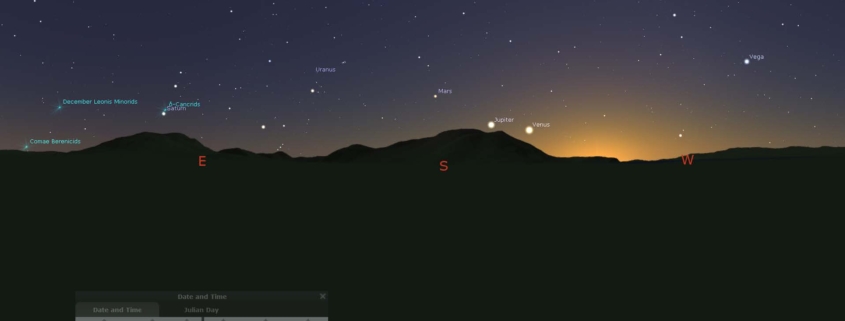Archaeoastronomy course: Re-creation of Natural Worlds – 6 October 2023
Re-creation of Natural Worlds: An introduction to the digital visualisation of past skies and landscapes
Date: 6 October 2023: 09:00-17:00
Location: Vrije Universiteit Amsterdam, New University Building (NU), room 6A04
Credits: 1 ECT
This course introduces students to the advantages of recreating natural visual-scapes observed by people in the past and the software applications that are used to do this. It will demonstrate how, by placing past people into their fuller visual contexts, we can generate clearer hypotheses about their lives and belief systems. This will include hands-on training in two primary digital applications that can re-create past land- and sky-scapes.
Course aims
We will review the relevance of visual-scapes in archaeological research, in particular within landscape archaeology and archaeoastronomy. We will see how such ‘scapes’ are keystones to understanding past peoples approaches to Life-ways, their place in the Universe along with Death, and how they generated their understandings of Nature and ideologies through their creations of ritual-scapes. Significantly, the course will provide an introduction to two key, publicly available software packages.
At the end of the course successful students will be able to:
1. demonstrate knowledge of key facts, issues, concepts and theories in the course;
2. recognise the need for an interdisciplinary approach to the study of archaeology;
3. demonstrate an awareness of the nature and consequences of human interactions with natural systems and cultural heritage.
At the end of the course, successful students will have foundational knowledge for understanding:
1. how to select, use and evaluate appropriate research methods and techniques of data collection and analysis for the study of field archaeoastronomy and landscape archaeology more generally;
2. the basic running of two pieces of software;
3. how to apply new knowledge to problem-solving and new situations in archaeological research.
Mode of delivery
A mixture of lectures and hands-on computer sessions will be given in order to handle the intellectual and technical nature of the course. The software packages are Horizon and Stellarium. The publicly available Horizon builds 2 and 2.5/3D models of landscapes upon which you can layer astronomical information as seen in the past. Unlike Stellarium it has the ability to output landscape and astronomical data that can be used for qualitative and quantitive assessments. Stellarium is a free open source planetarium for your computer. It shows a realistic sky in 3D, just like what you see with the naked eye, binoculars or a telescope. Most strikingly, the use of Stellarium can turn the whole observation exercise into a cinematographic experience through its video-like animation and ‘frame rate’ options. Used together, they provide a very sound set of resource material for work in landscape and past astronomical visual-scapes.
Teaching staff
Lecturer and Course Convenor: Dr. Gail Higginbottom (gail.higginbottom@incipit.csic.es)
https://csic.academia.edu/GailHigginbottom
https://gailhigginbottom.wixsite.com/mysite
https://twitter.com/GailHigginbott1
Software
A.G.K. Smith, 2020, Horizon User Guide and Implementation Notes. The user guide is part of the simple software download: http://www.agksmith.net/horizon (ONLY WORKS ON PCs)
Stellarium (ALL ONLINE): https://stellarium.org (WORKS ON APPLE AND PCs)
Look on the first page (right-hand-side column) for:
• all releases
• user guide
The guide is for the latest version. The version we will use will depend on the software available in the computing suites. In the meantime you can have a look at https://stellarium-web.org
Pre-course reading
Denham, T. 2022. (Definition of) Landscape archaeology. Encyclopedia of Geoarchaeology, Springer. https://link.springer.com/content/pdf/10.1007/978-3-030-44600-0_168-1.pdf
Richards-Rissetto, H. 2017. What can GIS + 3D mean for landscape archaeology?, Journal of Archaeological Science; 84: 10-21. https://doi.org/10.1016/j.jas.2017.05.005
Ruggles C. & Cotte, M 2010 Vol 1 & 2017 vol 2. Heritage Sites of Astronomy and Archaeoastronomy in the context of the UNESCO World Heritage Convention. Paris: ICOMOS. READ: Introduction in Vol 1 plus one other chapter from Vol 1 or 2.
C.L.N. Ruggles, 1999, Astronomy in Prehistoric Britain and Ireland (Yale University Press). Read first two chapters. A classic work that points out all of the issues underlying working in
archaeoastronomy even today.
A list of more literature on the topic can be found here.
Credits: ARCHON members can receive 1 ECT for attending the conference, reading the literature upfront and handing in a reflection report afterwards.
Registration:


